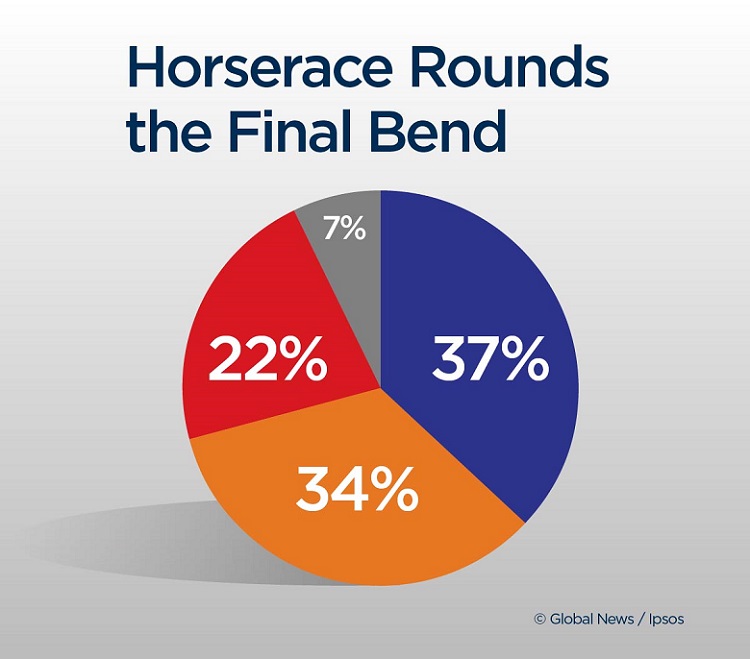With just over a week to go before Ontarians choose their next government, a new Ipsos poll suggests a mid-campaign NDP surge has been halted in its tracks — and Doug Ford‘s Progressive Conservatives are making a comeback.

The poll, conducted between May 25 and 27, would have captured at least some respondents after they watched the final leaders’ debate on Sunday night.
READ MORE: Wynne, Ford target Horwath in last leaders’ debate before June 7 election
If the election were held tomorrow, it revealed, the PCs would receive 37 per cent of the popular decided vote, up one point from last week. The NDP, meanwhile, has seen a softening of support — dropping from 37 to 34 per cent of the popular vote.
The Liberals remain stalled at 22 per cent (down one point since last week), while other parties, including the Green Party, have improved to 7 per cent (up 3 points) province-wide.
According to Darrell Bricker, CEO of Ipsos Public Affairs, the latest results suggest that voters began taking a more critical look at Andrea Horwath’s NDP once the party seemed poised to overtake the PCs.
WATCH: Ontario NDP surge in recent polls

“I think over the last couple of days, the last three or four days, some of the attention has started to turn on (the NDP),” said Bricker.
“The one thing, regardless of how you look at it, that seems to be pretty clear is that the Liberals are not going to be re-elected.”

Get breaking National news
At this point, he added, Premier Kathleen Wynne’s party is focused on “saving the furniture.”
One in 10 voters still say they’re unsure of who they would vote for, while another six per cent told Ipsos they would not vote or spoil their ballot.
“We know that probably upwards of 40 to 45 per cent of the people that we’re talking to aren’t going to show up,” Bricker noted.
READ MORE: Ford, Horwath spar in northern debate as Wynne defends her record
Indeed, turnout could prove to be the deciding factor in this election, especially in ridings where the race is too close to call. A full 82 per cent of PC voters responding to the Ipsos poll said they were “completely certain” they’d turn up to vote, while among NDP voters it was 69 per cent and among Liberal supporters it was 65 per cent.
That aligns with patterns Bricker has seen in the past.
“What we usually see is that older people, people who own homes, people who have a habit of voting, those people are the ones that tend to show up and they tend to be — in this election — more behind the conservatives.”
Regional variation
There continues to be significant variation in party support across different regions of the province.
In the 416 (downtown Toronto) area, Wynne has actually seen an impressive resurgence over the past week, increasing support for the Liberals from 27 to 33 per cent.
The PCs have simultaneously taken a six-point tumble, now sitting at 31 per cent, and the NDP are down five points to 29 per cent.
ANALYSIS: Here are the 20 closest riding races that could decide the Ontario election
The premier has been spending a lot of her time in the 416, Bricker said, and so the surge shows that this personal touch might actually be helping.
“But the truth is she’s not going to win the election in the 416. She has to win it in the 905 (GTA) and in the broader province.”
In Central Ontario, the PCs have solidified an already strong lead and now command half of the region’s support. While in the southwest, Bricker noted, the NDP is out in front and also enjoying strong support (43 per cent).
“That seems to be more of a labour vote, as you move up towards Windsor in particular,” he said.
What to watch for
Bricker said that as the campaign heads into its final week, he’ll be watching the Liberal numbers like a hawk.
“What I’m going to look for is to see whether or not the Liberal vote goes down any more. The real goal of the NDP in this campaign was to try and find a way of consolidating the progressive vote,” he explained.
“The problem they’re having right now is that they seem to have done a pretty good job … but the Liberals haven’t gone away enough.”
Horwath’s party needs to siphon more Liberal voters, he said, and get as many of those supporters as possible to polling stations on election day.
WATCH: Liberal MPP crashes NDP Leader Andrea Horwath’s event in Etobicoke

Doug Ford, meanwhile, may need to pivot attention toward some of his stronger female candidates (like his former leadership rival Caroline Mulroney) if he wants to lock down a win.
There remains a “huge” gender gap in PC supporters, with 42 per cent of men backing Ford compared to 33 per cent of women.
“Women really don’t like Doug Ford,” Bricker said. “His problem has been women — in particular, younger women — not being particularly attracted to what he’s got on offer. So they’re going to have to do something.”
These are some of the findings of an Ipsos poll conducted between May 25 and 27, 2018, on behalf of Global News. For this survey, a sample of 1,241 Ontario eligible voters was interviewed online and by telephone. The precision of Ipsos online polls is measured using a credibility interval. In this case, the poll is accurate to within ±3.2 percentage points, 19 times out of 20, had all eligible Ontario voters been polled.














Comments